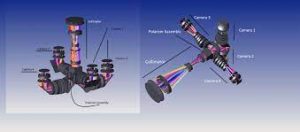PASIPHAE:

Polar-Areas Stellar-Imaging in Polarisation High-Accuracy Experiment (PASIPHAE) is an international collaborative sky surveying project.
- Scientists aim to study the polarisation in the light coming from millions of stars.
- Polarization is a property of light that represents the direction that the light wave oscillates.
- The survey will use two high-tech optical polarimeters to observe the northern and southern skies, simultaneously.
- It will focus on capturing starlight polarisation of very faint stars that are so far away that polarisation signals from there have not been systematically studied.
- The distances to these stars will be obtained from measurements of the GAIA satellite.
- By combining these data, astronomers will perform a maiden magnetic field tomography mapping of the interstellar medium of very large areas of the sky using a novel polarimeter instrument known as WALOP (Wide Area Linear Optical Polarimeter).
Significance of the project:
- The theory is that a small fraction of CMB radiation emitted during the universe’s rapid inflationary phase should have its fingerprints on a specific kind of polarisation, known technically as B-mode signals. These B-modes are theorised to have arisen as a result of powerful gravitational waves seen during inflation.
- However, these signals have been difficult to isolate because of the enormous amounts of polarised radiation in our own Milky Way, caused by large dust clouds that fill the galaxy.
- In essence, PASIPHAE endeavours to ascertain the effect of these obstacles, so we can, ultimately, learn how things played out in the early universe.




